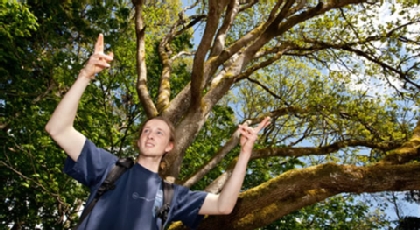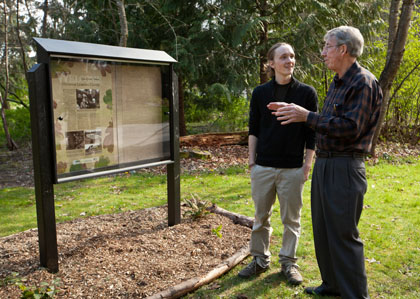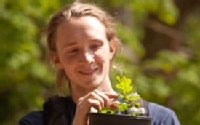Life of the Mind: One student’s journey shapes the landscape of PLU, by imagining the past
Standing under the branches of a Garry oak tree on the hill behind the University Center, Reed Ojala-Barbour ’11 takes stock of the open space in front of him.
He’s imagining what it must have been like more than 100 years ago – before the basketball court, sand volleyball court, and the well-manicured lawn bordered by a dry creek bed and residence halls.
 Reed Ojala-Barbour ’11 stands beneath a nearly 400 year-old Garry oak tree (Photos by John Froschauer)
Reed Ojala-Barbour ’11 stands beneath a nearly 400 year-old Garry oak tree (Photos by John Froschauer)
He thinks about how the dry creek bed once flourished as Clover Creek, with the surrounding vegetation part of a large prairie. The tree that he stands under today was there back then; it is nearly 400 years old. It is native to the area, one of more than 100 Garry oak on campus, making PLU a preserve of a species native to Pierce County.
The open space is an indication of what the entire area once was, Ojala-Barbour, an environmental studies major, said of the Clover Creek watershed on which the PLU campus sits. “That’s a little piece of evidence that used to be prairie,”
It’s something he could have learned in a book – and he certainly did – but his experience at PLU extends well beyond the classroom. His experience here led him to work with professors who have long been retired, community groups who offer funding and volunteers, PLU staff who help manage the campus.
Not only did Ojala-Barbour turn this passion into a degree, but his passion changed the landscape of PLU.
That passion was celebrated last April during Earth Week, when about 60 students, faculty, staff and community joined Ojala-Barbour, PLU President Loren J. Anderson and Professor Emeritus of Chemistry Fred Tobiason to dedicate the Fred L. Tobiason Outdoor Learning Center. The native space behind the University Center has become a symbol of what one student, with a lot of on-campus support, can do when he follows his passion.
 Reed Ojala-Barbour ’11, talks with Fred Tobiason, professor emeritus of chemistry, during the dedication of the Fred L. Tobiason Outdoor Learning Center at PLU on Monday, April 18, 2011.
Reed Ojala-Barbour ’11, talks with Fred Tobiason, professor emeritus of chemistry, during the dedication of the Fred L. Tobiason Outdoor Learning Center at PLU on Monday, April 18, 2011.
The project, culminating with a ceremonial blackberry-vine cutting this April, was three years in the making.
When Ojala-Barbour was looking for a summer job upon returning to campus his sophomore year from Spain, it was suggested he apply for a Sustainability Fellowship.
The fellowship had great appeal – he’d have a job, and the chance to make a positive impact on the campus of his university.
He dived into researching PLU’s footprint, and he proposed studying the impact of invasive species to native plants on the PLU campus. It wasn’t long before he’d learn about the Garry oak and it’s unique place as a native species of the area.
Even though the university long has embraced sustainable practices, such as setting a goal of being a carbon neutral by 2020 or investing in green building and renovation practices, Ojala-Barbour knew there was always more to do.
“I realized PLU wasn’t doing all it could for the native area, but there was a network of people who could,” he said.
But he also learned about many people who have been active in preserving green spaces in the area. One of those people was Fred L. Tobiason, a former chemistry professor at PLU.
“I’d be talking to other people and they’d say ‘have you talked to Fred Tobiason?’” Ojala-Barbour recalled. “He sort of showed me the to ropes around the Clover Creek watershed.”
Taking inspiration from Tobiason, Ojala-Barbour targeted a space behind the UC that, back in the 1970s, Tobiason saved from becoming a parking lot. The site had been inaccessible for years, thanks to dense thickets of Himalayan blackberries, an invasive species that negatively affects the Garry oak tree.
He began going to conservation group meetings and learning all he could. It was at a Pierce County Conservation District meeting that he first heard about grants that were available to help promote preservation.
With the help of PLU staff, Ojala-Barbour submitted grant proposals to the Greater Tacoma Community Foundation and the Green Partnership Fund.
Help and support from people on campus including Professor of Biology William Teska and Sustainability Coordinator Chrissy Cooley, made learning how to write a grant proposal a lot less daunting.
By the fall of 2009, Ojala-Barbour learned the grants had been awarded to his project.
“That’s when things really got going because we knew we had the funds,” he said.
By working with the Native Plants Salvage Alliance, he was able to secure native seeds and native species for replanting on campus. Plants like snowberry, Oregon grape and beaked hazelnut. All in all, there were 25 plant types for replanting.
The money was there, and there were people ready to get their hands dirty, but they needed a voice to organize them. They needed someone to lead them and focus on making a difference in their environment.
“I just realized it was an opportunity for me to be a leader,” Ojala-Barbour said.
 Reed Ojala-Barbour holds one of the Garry oak saplings that will one day take root on the PLU campus.
Reed Ojala-Barbour holds one of the Garry oak saplings that will one day take root on the PLU campus.
The Clover Creek watershed is a unique environment, he said, just like PLU. Campus leadership was supportive of his efforts. “PLU has a unique climate of getting students involved in the institution,” Ojala-Barbour said. He learned that although PLU staff couldn’t do all the work, he found a network of people passionate about the Clover Park watershed, in and around the PLU community. Local seniors from Washington High School and volunteers from the PLU sustainability club, GREAN, Girl Scout troops, Boys and Girls Club members, and students from the Little Buddies club gladly lent a hand to clear the site of blackberries, and collect acorns of Garry oak. More than 100 people were involved in the project.
Ojala-Barbour came to PLU interested in environmental studies, but never imagined he’d be able to engage his passion so completely.“It’s been a lot of time and energy, but its also been really rewarding,” Ojala-Barbour said.
Someday, he hopes to combine the land management skills he’s learned outside of the classroom, with what he’s learned inside the classroom, and work to better preserve what native land remains.
This fall, Ojala-Barbour will be in Ecuador, as a Fulbright Fellow, studying small mammals and the environmental impacts on them.
He calls it another chance to get his hands dirty. After his experiences at PLU, he’s not sure if there’s any other way to learn. He hopes the environmental work he’s done carries on to the next generation of students. There’s still a lot to be done. The work is never over, he said.
“I’m hoping it will become more of a campus culture,” he said. “I’m hoping we can be better stewards of pieces of nature we have left. Good stewards recognize the impact we have on the environment.”
Today, evidence of that stewardship is taking root at PLU, with the Fred Tobiason Outdoor Learning Center and below the far-reaching Garry oak where Ojala-Barbour first took notice of the prairie at PLU.
Below the 400 year-old tree, a dozen foot-tall saplings of the Garry are taking root, taking hold of the land they once called home. And with a little hard work, and help, will once again.



